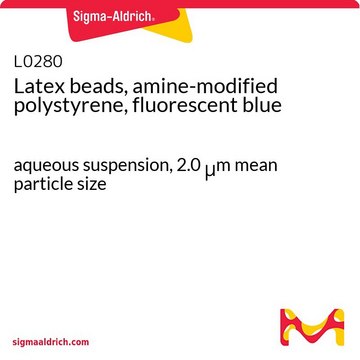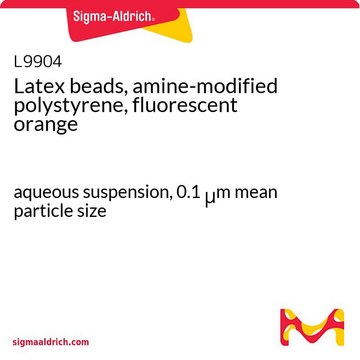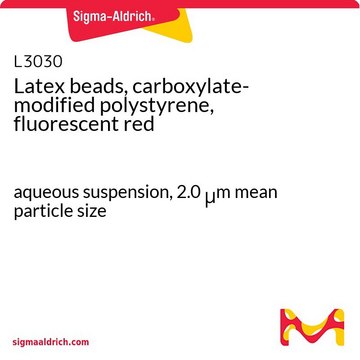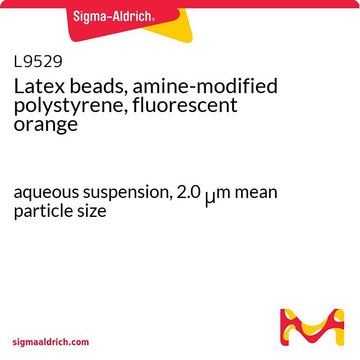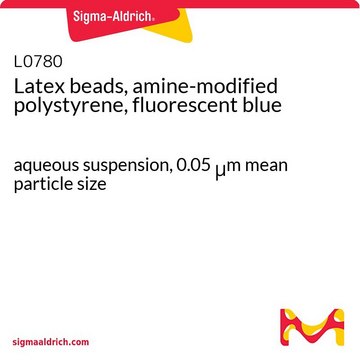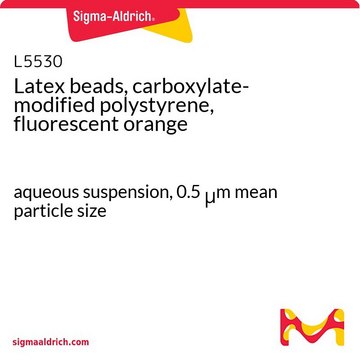L1030
Latex beads, amine-modified polystyrene, fluorescent yellow-green
aqueous suspension, 1.0 μm mean particle size
Iniciar sesiónpara Ver la Fijación de precios por contrato y de la organización
About This Item
Productos recomendados
formulario
aqueous suspension
Nivel de calidad
composición
Solids, 2.5%
técnicas
cell based assay: suitable
tamaño medio de partícula
1.0 μm
fluorescencia
λex ~470 nm; λem ~505 nm
aplicaciones
cell analysis
¿Está buscando productos similares? Visita Guía de comparación de productos
Aplicación
Latex beads, amine-modified polystyrene, fluorescent yellow-green have been used:
- in the characterization of nano- and microplastics
- in tendon preparation to label tendon fascicles to enable precise localization of the tissue surface
- in phagocytosis assay to label spleen cells
Acciones bioquímicas o fisiológicas
Polystyrene latex beads can be used to create latex agglutination systems. It can be used to study the transmission of Mycobacterium leprae, the causative pathogen of leprosy. These beads are also utilized to develop a method for mass screening for both pulmonary and extrapulmonary tuberculosis.
Código de clase de almacenamiento
10 - Combustible liquids
Clase de riesgo para el agua (WGK)
WGK 2
Punto de inflamabilidad (°F)
Not applicable
Punto de inflamabilidad (°C)
Not applicable
Certificados de análisis (COA)
Busque Certificados de análisis (COA) introduciendo el número de lote del producto. Los números de lote se encuentran en la etiqueta del producto después de las palabras «Lot» o «Batch»
¿Ya tiene este producto?
Encuentre la documentación para los productos que ha comprado recientemente en la Biblioteca de documentos.
Los clientes también vieron
Sean Spanik et al.
Journal of contaminant hydrology, 243, 103919-103919 (2021-11-12)
The transport of cationic amine-modified latex (AML) and anionic carboxylate-modified latex (CML) microspheres through a discrete sandstone fracture with mineralogical heterogeneity and roughness was studied. Two microsphere sizes (200 nm and 1000 nm), two ionic strengths (5 mM and 10 mM), and two specific
Ivan Gusachenko et al.
Biophysical journal, 102(9), 2220-2229 (2012-07-25)
Collagen is a triple-helical protein that forms various macromolecular organizations in tissues and is responsible for the biomechanical and physical properties of most organs. Second-harmonic generation (SHG) microscopy is a valuable imaging technique to probe collagen fibrillar organization. In this
James M May et al.
Archives of biochemistry and biophysics, 440(2), 165-172 (2005-08-02)
Since activated macrophages generate potentially deleterious reactive oxygen species, we studied whether ascorbic acid might function as an antioxidant in these cells. Thioglycollate-elicited murine peritoneal macrophages contained about 3 mM ascorbate that was halved by culture in ascorbate-free medium. However
Jing Liu et al.
Fish & shellfish immunology, 82, 136-146 (2018-08-14)
Clam Ruditapes philippinarum is one of the most important commercial aquaculture species in China. The haemocytes play vital roles in internal defense of the calm. In this investigation, classification and immune functions of R. philippinarum haemocytes were identified. The haemocyte
Fancong Kong et al.
Experimental and therapeutic medicine, 10(6), 2093-2101 (2015-12-17)
Microvesicles (MVs) in body fluids participate in a variety of physical and pathological processes, and are regarded as potential biomarkers for numerous diseases. Flow cytometry (FCM) is among the most frequently used techniques for MV detection. However, different handling methods
Nuestro equipo de científicos tiene experiencia en todas las áreas de investigación: Ciencias de la vida, Ciencia de los materiales, Síntesis química, Cromatografía, Analítica y muchas otras.
Póngase en contacto con el Servicio técnico

